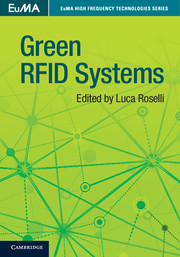Book contents
- Frontmatter
- Contents
- List of contributors
- Introduction
- 1 Context analysis
- 2 RFID background
- 3 Energy scavenging and storage for RFID systems
- 4 Technologies for RFID sensors and sensor tags
- 5 Unconventional RFID systems
- 6 Integrating tiny RFID- and NFC-based sensors with the Internet
- 7 Materials for substrates
- 8 Organic conductors and semiconductors: recent achievements and modeling
- 9 RFID enabling new solutions
- 10 Energy-efficient off-body communication using textile antennas
- Index
- References
2 - RFID background
Published online by Cambridge University Press: 05 October 2014
- Frontmatter
- Contents
- List of contributors
- Introduction
- 1 Context analysis
- 2 RFID background
- 3 Energy scavenging and storage for RFID systems
- 4 Technologies for RFID sensors and sensor tags
- 5 Unconventional RFID systems
- 6 Integrating tiny RFID- and NFC-based sensors with the Internet
- 7 Materials for substrates
- 8 Organic conductors and semiconductors: recent achievements and modeling
- 9 RFID enabling new solutions
- 10 Energy-efficient off-body communication using textile antennas
- Index
- References
Summary
RFID system architecture
RFID (Radio Frequency IDentification) indicates the capability of identifying by means of radio frequency transmissions. The identification involves assigning a unique identity to an object that is distinguishable in an unambiguous way.
In this original form RFIDs have the same functionality as a barcode. Regarding its evolution, the main purpose of this technology, beyond barcodes, is to obtain identified information about objects, animals, or persons by means of small apparatuses working at radio frequency.
The intake of information is achieved by means of searching operations, identification, selection, spatial localization, and tracking.
Identifier and identified communicate using radio frequency signals, hence no physical contact (unlike, for example, use of magnetic stripe cards) is needed.
The predecessor of the RFID system is commonly recognized as being “Identification Friend or Foe (IFF),” developed in England during World War II (1940) [1–3]. The equipment on board allied aircraft had the functionality of answering if questioned, thus identifying allied planes and distinguishing them from enemy aircraft.
identifying allied planes and distinguishing them from enemy aircraft. The technology has then evolved differently into systems for following the route of railway wagons, for the automation of processes in the automotive industry, for the location of livestock and wildlife, for anti-theft in the retail trade, for keys and electronic documents, and in agriculture and nature reserves, etc. [4–6].
- Type
- Chapter
- Information
- Green RFID Systems , pp. 17 - 37Publisher: Cambridge University PressPrint publication year: 2014

